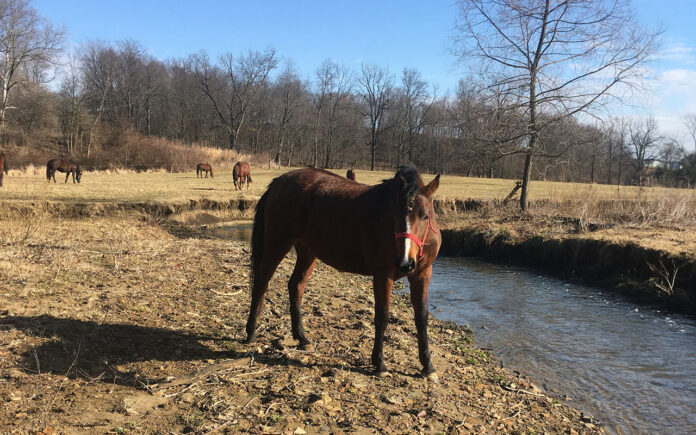When the Environmental Protection Agency comes to visit, you never know how the visit might go. This past week, Holmes County was happy to receive these visitors to a project site that had taken the better part of three years to complete. By the end left everyone with a smile on their face.
The Rush Run stream restoration focused on a small but mighty creek that was causing a nightmare of erosion and sediment deposition; but working together on it cemented good agency partnerships, seeded the prospect for future stabilization and restoration projects and will yield stream health benefits for the wildlife and people who live here.
Problems
Like hundreds of headwater streams in our area, Rush Run was falling victim to a combination of natural and human-caused changes: Heavier, more intense rainfall, longer dry seasons, timbering, channel modifications and livestock with unrestricted access to the stream. The sandy, gravel-dominated soils were not strong enough to hold up during flooding, because horses had destroyed the bank stability and most of the vegetation lining the channel. As a result, the stream would change course, sometimes multiple times a year, snaking back and forth across the pasture like a cracking whip.
The downstream effects caused issues impacting landowners, township, and county personnel. The stream channel would fill up with sand and gravel that caused water to come up and spill out over the banks even during moderate rainfall. This impacted two township bridges and a significant county highway bridge that had recently been completely reworked by the highway department. During periods of high flow, tree trunks and other debris would get carried toward the roads and bridges, threatening the infrastructure. Floodwater would make the roads impassable and always left significant cleanup efforts afterwards.
Partnership
A good partnership between the Holmes County Engineer and Holmes Soil and Water Conservation District meant that a restoration project was designed that would meet goals for several stakeholders. The SWCD office took the lead on writing a 9 Element Plan, and the accompanying grant for EPA Section 319 funding, which is targeted at projects that produce water quality improvements.
Rush Run is a tributary to Killbuck Creek, and empties into the river within the Killbuck Marsh Wildlife Area, which has excellent fish populations. Improving water quality in the headwaters leads to habitat improvements for downstream species, as well as boosting important physical and chemical indicators (such as a reduced sediment load, lower temperatures, lower nitrogen and phosphorous loads and increased oxygen in the water column).
The county engineer solicited proposals to address this challenge and received restoration designs from EnviroScience, an environmental engineering firm. The strategy was to employ a combination of large stone, large tree trunks and limbs for “cribbing” and live vegetation in a completely realigned channel that took into consideration the meandering nature of this system. It also required fencing out the restoration area to allow trees, shrubs and grasses to grow and develop deep roots capable of holding on during high water.
The engineer’s office took charge of bidding out the project and selecting a contractor. While the selected firm had never built a stream before, they were willing to follow the guidance of the design firm, who stayed on-site for the construction phase. This was especially important when the site got hit by multiple February rains, destroying portions of the restoration, which had to be reworked several times. This put the designs to the test, but once the backhoes were finished and the grasses and willows started to root, it was clear that the site was on solid ground.
Final work
Finalizing the project was set back in June when the area was hit with a derecho, a storm that dumped inches of rain in one night, and toppled thousands of trees across northern Holmes and southwestern Wayne counties.
Though forced to cancel the planting event where FFA students would have planted native trees in the riparian area, the bright spot was that the stream behaved exactly as was intended. The water came up but couldn’t erode any of the restoration area due to all the reinforcement now in place. The trees were planted the following week by SWCD staff and field staff from EnviroScience. A few weeks later the fencing company was finally able to finish off the project by installing over 3,000 feet of fence.
The farmer whose pasture the project was located on was incredibly patient with the whole process, which included losing access to their gas during the last weeks of cold weather in early spring and having to juggle his horses around to neighboring pastures for months on end.
However, he was able to negotiate a mutually beneficial element to the project. Instead of just the required 15-foot buffer to the stream, he fenced out approximately 12 acres to use as turkey habitat and a bird corridor along the stream. The Muskingum Watershed Conservancy District funded the fence portion of the project, which also helped establish an off-stream waterer for his horses.
This project is a drop in the bucket for the many areas (not just in our county) fighting stream erosion and stormwater issues, but it’s a victory nonetheless. By partnering with multiple groups and agencies across local, state, and federal levels, soil and water offices can help leverage and coordinate the financial and technical resources to achieve improvements across different landscapes and scenarios — and that’s a win for the rivers, critters, and people who want to continue to thrive here. If you need assistance addressing concerns in your area, please don’t hesitate to contact your SWCD.













